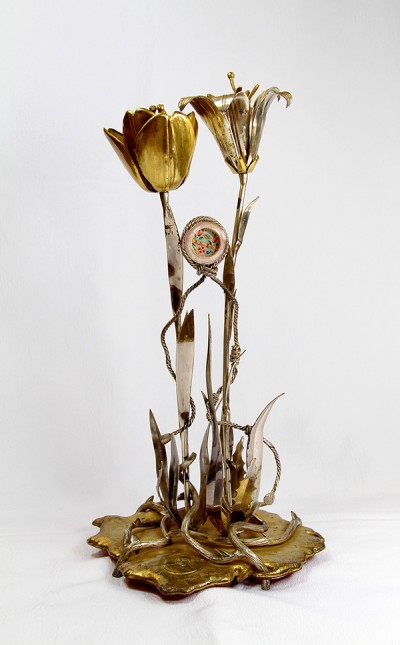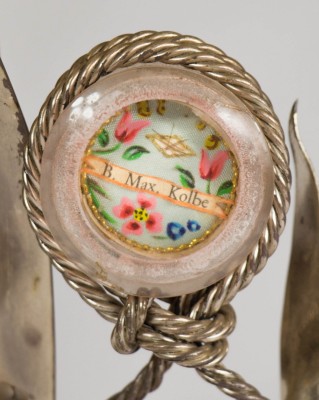St. Maximilian Kolbe Relic Tour Begins in U.S.

The major relics of Maximilian Kolbe, who was canonized by St. John Paul II, began an 8-month tour Jan. 15-17 in Ellicott City, Md., at the Shrine of St. Anthony. The tour started with noon Mass at the shrine.
The tour sponsored by the Franciscan Friars Minor Conventual of the Our Lady of the Angels Province will continue until August 14, the date commemorating the 75th anniversary of Kolbe’s martyrdom in the World War II Nazi concentration camp in Auschwitz, Poland.
The pilgrimage will be historic — the largest tour of his relics ever mounted in the United States. Traveling up and down the east coast and also into Canada, St. Maximilian's relics will visit 39 sites. At each site there will be a liturgy, opportunities for veneration, time for prayer and material for study.
Most stops will be for two days, such as an early one at St. Casimir Church in Baltimore, Md., on Jan. 22-24, and later ones such as St. Francis of Assisi Church in Athol Springs, N.Y., on May 20-22. A few will last several days, like the one scheduled at Catholic University of America in Washington for Feb. 17-21.

The large silver and bronze reliquary presents different symbols from his life and, notably holds strands from St. Maximilian’s beard. Because he was martyred at Auschwitz, these are the only remaining first class relics — something that was part of a saint’s body.
In 1938, the saintly friar returned from a missionary journey to Japan sporting a full, long beard. He had grown it to help his missionary work in Japan because the beard earned the respect of those people who was there to serve. But in Poland, the beard was more than a detraction.
Under the country’s National Socialism, the beard incited his own persecution and the persecution of fellow friars — there were hundreds in the monastery, a phenomenal number.
One book on his life offers this quote from the saint: “Beards provoke the enemy who rapidly is approaching our friary. Our Franciscan habits also will provoke him. I can part with my beard. I can’t sacrifice my habit.”
Joseph Hamilton, spokesman for the tour and director of development for the Franciscan Friars Conventual in Ellicott City, told the story of how Maximilian’s beard came to be saved.
“He was the only friar in Poland like that at the time. All the others were clean shaven,” Hamilton explained. In the fall of 1939 when the Nazis invaded Poland, the printing presses established by Maximilian Kolbe were running 24 hours a day.
“He was on the Nazi radar,” Hamilton emphasized. His superior told him it was better he shaved his beard off so as not to stand out in the society.
Hamilton described how “the brother shaving off the beard put it aside. Maximillian saw it and asked what he was doing.” Then he told the barber brother to throw the beard into the fire. The brother did, but there were no coals.
“So when Maximilian left, he fished it out. By 1939 he was a ‘force’, so the guys knew we better grab some relics while we can," Hamilton said.
Indeed Maximilian Kolbe was a “force” on the watch list. He founded the Militia Immaculata (MI), an evangelization movement identifying with Mary, the Immaculate. He founded “Cities of the Immaculata” in Niepokalanow, Poland outside Warsaw, and in Nagasaki, Japan.
Religious works poured from the printing presses in Niepokalanow including a daily newspaper with a circulation of 230,000 and a monthly magazine with over one million circulation. Friars and seminarians there numbered an astounding 782 already by 1936.
Of course, in 1939 Maximilian was arrested along with 50 other friars, but they were released. He was arrested again on Feb. 17, 1941. This time he would not make it out. It didn’t come as a surprise because, Hamilton told me, “After the first arrest they knew.”
The barber friar’s decision to save the beard turned out to be providential.
After the Gestapo arrested him the second time, he was sent to Auschwitz where he volunteered to take the place of an innocent husband and father to be executed. Maximilian died a martyr on Aug. 14, 1941.
Hamilton added more details about the relic. He said a large chunk of beard was stuffed into a pickle jar. Today two main or biggest sections of it are split between Rome and Poland. Some of the strands were placed into four identical reliquaries. One is used for this pilgrimage.
Father James McCurry of the Franciscan Friars Conventual and minister provincial of the Our Lady of the Angels Province, explained the importance of relics.
“Relics remind us that saints were real human beings with hair, skin, bones and blood,” he noted. “We venerate relics to connect with the real person behind them — now proclaimed by the Church to be in Heaven, from where he or she remains interested and involved in our lives.”
The Reliquary
The large silver and bronze reliquary holding the strands from Maximilian’s beard in a glass case is quite unique. It’s designed to include important symbols from his life too.
The base is shaped like Poland, the place of his birth and where his vocation and work first flourished. “Thorns” grow from this Poland symbolizing the occupation by the Third Reich and then the Auschwitz concentration camp too.
But from the thorns grow a lily symbolizing purity and a tulip symbolizing martyrdom. The flowers tell how God made him blossom like a lily, while both flowers symbolize his love being victorious over hate.
The glass case holding the strands from his beard is encircled by a Franciscan cord with its tradition three knots for the three Franciscan vows. It symbolizes his vocation.

Year of Mercy Saint
In 1982 St. Pope John Paul II canonized Maximilian as a "Martyr of Charity" and “patron saint of our difficult century.” St. Maximilian Kolbe is also the patron saint of prisoners, families, the pro-life movement, journalists, and chemically addicted.
How do the Franciscans of Our Lady of the Angels Province see this pilgrimage fitting into the Year of Mercy?
"St. Maximilian Kolbe died as a ‘Martyr of Charity’ at Auschwitz Concentration Camp 75 years ago (Aug. 14, 1941). His death bore witness to "mercy" par excellence,” Father McCurry told the Register. “Its anniversary aptly coincides with the Church’s Jubilee Year of Mercy.”
The minister provincial explained, “Mercy — in Latin, Misericordia — means ‘to feel in one’s heart the misery of others.’ Moved with such compassion for the miserable plight of a fellow prisoner, St. Maximilian offered to take the condemned man’s place in a starvation bunker. His martyrdom was an act of mercy, showing that God uses ordinary men and women to exemplify extraordinary love of neighbor."
This relic tour again brings to light that act of mercy in this jubilee year.
See the complete pilgrimage itinerary here.











